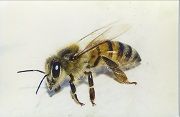Article
Study Finds Low Risk of Systemic Reaction Following Bee Sting in Patients Who Had Previously Been Stung
Author(s):
Are most people who show mild sensitivity to bee venom a sting away from developing systemic allergies and suffering anaphylaxis? New research suggests the answer is no, but they are in danger of serious reactions at the sting site.

Are most people who show mild sensitivity to bee venom a sting away from developing systemic allergies and suffering anaphylaxis? New research suggests the answer is no, but they are in danger of serious reactions at the sting site.
The Austrian study, which was published in the Journal of Allergy and Clinical Immunology, began when doctors from the University of Graz found 110 people who were sensitized to stings. All these subjects produced a specific IgE antibody (sIgE) in response to at least one type of Hymenoptera venom but suffered no systemic sting reactions (SSRs) such as anaphylaxis.
The researchers then asked these subjects to allow themselves to be stung by a bee, a wasp, or both (depending on which venom or venoms induced each patient’s initial antibody response). Surprisingly, only 16 refused. The other 94 submitted to 131 stings, 76 from bees, 53 from wasps.
Researchers measured reactions after 3 hours, 1 week and 4 weeks and asked a subset of 18 patients to come back after a year for another round of stings and measurements.
Of all the patients stung during the first round of the project, only 5 (5.3%) had SSRs, but 41 (43.6%) had large local reactions (LLRs) after the sting.
Researchers compared those figures to the best available numbers for the public at large and concluded that patients who once exhibited mild reactions to bee or wasp venom were 9.5 times more likely to suffer an LLR from a subsequent sting but not significantly more likely to suffer anaphylaxis or any other SSR.
What if those people suffer yet another sting?
A year after that initial experiment took place, 18 of the subjects returned for a re-sting. Half of them had an LLR, but none had an SSR.
“On the basis of our experience, we would have expected more SSRs and, particularly, a higher frequency of SSRs in subjects with lower total IgE (tIgE) levels,” the authors wrote.
Only 1 (2.7%) of 37 subjects with low IgE levels experienced an SSR, compared to 1 (3.4%) of 29 with intermediate levels and 3 (10.7%) of 28 with high tIgE. Those apparent differences, however, were not significant (P 5.384).
As for LLRs, the results were similar: neither high nor low nor moderate tIgE levels had any significant correlation with the frequency of LLRs. “This confirms again that current diagnostic tools cannot predict the occurrence of an LLR or SSR,” the authors wrote.
The research team noted several limitations to the study, including the timing of the second stings. By the time subjects returned a full year later, their IgE levels had very nearly returned to baseline, which may have reduced the chance of their reactions escalating.
The researchers think that subsequent stings given just a month after initial stings — when tIgE levels were still elevated several-fold in most patients — might have triggered more instances of anaphylaxis.
Still, the authors concluded that “there is no action needed in sensitized subjects who have never experienced allergic symptoms after a sting… the increase in sIgE levels after a sting does not indicate conversion into clinically relevant hypersensitivity and is reversible after 1 year.”



